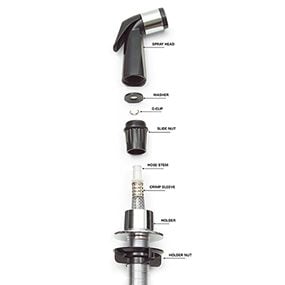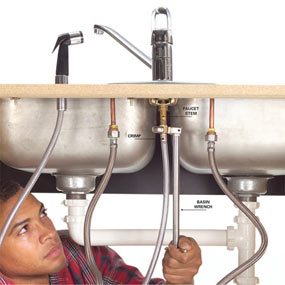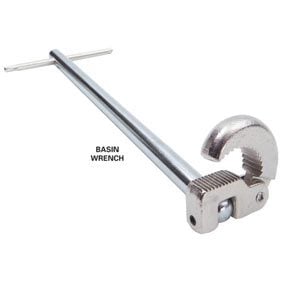Sink Sprayer Leaking? Here’s How to Fix It
Updated: Oct. 13, 2023
Is your sink sprayer leaking? Diagnose and cure pullout sprayer problems with this step-by-step guide.
Introduction
Sink sprayers can develop leaks just like any other water line, but they're trickier to spot. The solution usually involves replacing either the spray head or the spray head and hose together.Tools Required
- 4-in-1 screwdriver
- Adjustable wrench
- Flashlight
- Pliers
- Plumbers tape
- Slip joint pliers
- Utility knife
Project step-by-step (6)
Kitchen Faucet Spray Head Replacement
If you find mysterious puddles under your kitchen sink, the most likely suspects are the water supply lines, the drain lines or the seal between the sink and the countertop. But don’t forget about the pullout sprayer. Sink sprayer leaks can fool you because they usually occur only when the faucet is running. There are only two fixes: Either replace the spray head or both the spray head and the hose.
First, check the spray head for leaks. Turn on the faucet and pull out the spray head. Make sure the slide nut is tightly screwed into the spray head. Check for leaks, then push the trigger and check again. If water leaks out from under the slide nut, remove the spray head and slide nut. Turn on the faucet and look for leaks around the crimp sleeve. If you find leaks around the crimp, you’ll have to replace the hose and the head. If the crimp doesn’t leak, simply replace the head. Replacements are sold at home centers and hardware stores.
If the spray head doesn’t leak, grab a flashlight, turn on the faucet and check under the sink. Give the hose a quick inspection, then examine the connection under the faucet. If you find a leak at the crimp, replace the hose. If the leak is coming from the stem connection, try to tighten it. You might be able to tighten it with small pliers, but it’s tight quarters under there. The best tool for this job is a basin wrench (sold at home centers and hardware stores). If tightening doesn’t solve the problem, replace the hose (Photo 2).
Hoses usually aren’t sold separately, so you’ll get a new spray head, too. Some hoses have a female fitting that fits over the faucet stem. Others screw into the faucet stem. Many spray head/hose kits include an adapter so the hose can connect to male or female threads. Also pick up a roll of pipe-thread tape and wrap the male threads before you connect the new hose. You don’t have to turn off the water supply to replace the hose, but make sure no one turns on the faucet while the hose is disconnected!
Most spray heads and hoses are interchangeable parts. But some spray heads and hoses connect differently. Home centers and hardware stores usually carry only the standard type shown here. If you have a different type, call a plumbing supplier (in the Yellow Pages under “Plumbing, Fixtures”) or go to any online search engine and type in the manufacturer of your faucet followed by “replacement parts.”
Replace the spray head only
Unscrew the spray head from the slide nut. Remove the washer and pry off the C-clip with a small screwdriver or pocket knife. To install the new head, reverse these steps.

Spray head assembly
Lay out the sink sprayer parts in order if you replace the spray head.

Replace the spray head and hose
Unscrew the hose with a basin wrench. Feed the new faucet hose through the holder. Wrap male threads with pipe thread tape. Screw the hose to the faucet stem by hand. Then tighten the connection with the basin wrench.

Basin wrench
Use a basin wrench for hard-to-reach spots under the sink.

Diverter Valve Issues
Inside your faucet, there’s a “diverter” valve, which stops the water flow to the spout and sends it to the sprayer when you press the sink sprayer head’s trigger. Here are the symptoms of diverter trouble:
- Very little water, or none at all, comes out of the sprayer when you press the trigger. A bad sprayer head can cause this, but more often the diverter is the culprit. To check this, remove the sink sprayer head and turn on the faucet. If the water flow out of the hose is weak, the diverter is to blame.
- The sprayer pulsates like a machine gun.
- Water continues to flow out of the faucet spout when you’re using the sink sprayer.
Often, a misbehaving diverter needs only light scrubbing with a toothbrush and a good rinse. But since removing a diverter usually requires major faucet disassembly, it’s best to simply replace the diverter rather than risk taking it apart again.
Diverter styles and removal procedures differ widely. Some are small valves like the one shown here. Others are larger cylinders that don’t look like valves at all. Some newer diverters aren’t inside the faucet but are instead connected to the sprayer hose below. So the first step in diverter repair is finding a diagram of your faucet. If you can’t find your owner’s manual, do an online search. Type in the manufacturer of your faucet followed by “faucet parts diagram.” With a little searching, you’ll find an illustration showing your faucet’s internal parts. You’ll also find several sources for replacement parts online. To find a local supplier, check the Yellow Pages under “Plumbing, Fixtures” or search online.
